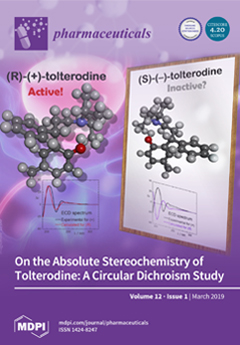The benefits of PET imaging of tumor hypoxia in patient management has been demonstrated in many examples and with various tracers over the last years. Although, the optimal hypoxia imaging agent has yet to be found, 2-nitroimidazole (azomycin) sugar derivatives—mimicking nucleosides—have proven their potential with [
18F]FAZA ([
18F]fluoro-azomycin-
α-arabinoside) as a prominent representative in clinical use. Still, for all of these tracers, cellular uptake by passive diffusion is postulated with the disadvantage of slow kinetics and low tumor-to-background ratios. We recently evaluated [
18F]fluoro-azomycin-
β-deoxyriboside (
β-[
18F]FAZDR), with a structure more similar to nucleosides than [
18F]FAZA and possible interaction with nucleoside transporters. For a deeper insight, we comparatively studied the interaction of FAZA,
β-FAZA,
α-FAZDR and
β-FAZDR with nucleoside transporters (SLC29A1/2 and SLC28A1/2/3) in vitro, showing variable interactions of the compounds. The highest interactions being for
β-FAZDR (IC
50 124 ± 33 µM for SLC28A3), but also for FAZA with the non-nucleosidic
α-configuration, the interactions were remarkable (290 ± 44 µM {SLC28A1}; 640 ± 10 µM {SLC28A2}). An improved synthesis was developed for
β-FAZA. For a PET study in tumor-bearing mice,
α-[
18F]FAZDR was synthesized (radiochemical yield: 15.9 ± 9.0% (
n = 3), max. 10.3 GBq, molar activity > 50 GBq/µmol) and compared to
β-[
18F]FAZDR and [
18F]FMISO, the hypoxia imaging gold standard. We observed highest tumor-to-muscle ratios (TMR) for
β-[
18F]FAZDR already at 1 h p.i. (2.52 ± 0.94,
n = 4) in comparison to [
18F]FMISO (1.37 ± 0.11,
n = 5) and
α-[
18F]FAZDR (1.93 ± 0.39,
n = 4), with possible mediation by the involvement of nucleoside transporters. After 3 h p.i., TMR were not significantly different for all 3 tracers (2.5–3.0). Highest clearance from tumor tissue was observed for
β-[
18F]FAZDR (56.6 ± 6.8%, 2 h p.i.), followed by
α-[
18F]FAZDR (34.2 ± 7.5%) and [
18F]FMISO (11.8 ± 6.5%). In conclusion, both isomers of [
18F]FAZDR showed their potential as PET hypoxia tracers. Differences in uptake behavior may be attributed to a potential variable involvement of transport mechanisms.
Full article






